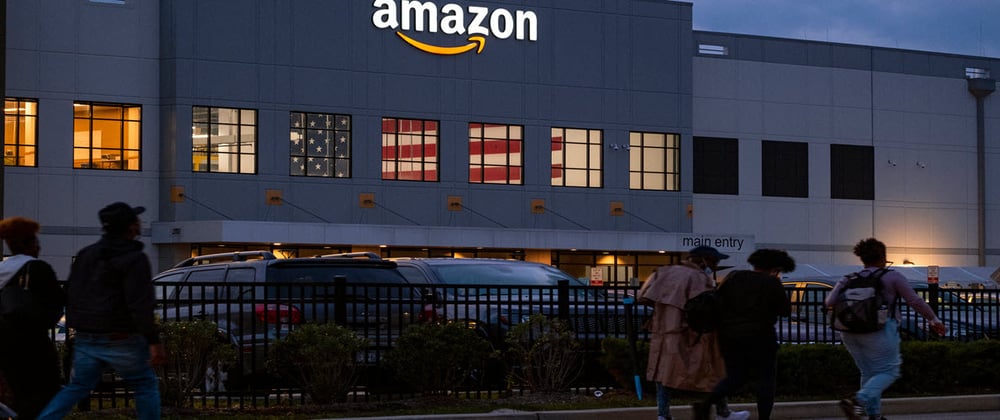Last year I wrote a couple articles about my "Amazon journey". You can read them here https://dev.to/bytebodger/how-i-got-hired-at-amazon-3ajl and here https://dev.to/bytebodger/what-its-like-to-code-for-amazon-4nke. My Amazon "career" lasted all of 10 months. On January 18th, Amazon released 18,000 workers. And I was one of them.
I've hemmed-and-hawed over writing this article for a few months. The first few times I tried to write this, it was wayyyy too bitter, and it would've come across merely as "sour grapes". So I scrapped those original drafts. But now, after having a few months' separation from the Amazon machine... I think it's time.
I'm gonna be frank here. This article is basically my own self-administered therapy. If it doesn't strike you as being "professional" or if you feel like hopping into the comments and deriding me for my opinions, well... I really couldn't care less. You can write your own blog post about how I'm an idiot, or about how everyone jettisoned from Amazon deserved what they got, or about how this is all just "the way of the world". But this is my post. And I'm gonna explain things exactly as I experienced them.
Laying My Cards On The Table
Before I get into details, I wanna be dead-honest about a few key points. First, there's nothing about my experience that can be taken as a blanket statement on Amazon as a whole. The company is huge. Their workforce - even after the layoffs - is huge. There are still more than a million Amazon employees. And even if we filter out all the non-coders, it's still a massive workforce. So if you worked at Amazon in the past, or if you work there now, your experience may be completely different from my own.
Second, I can honestly tell you that I was "all-in". I sincerely hoped that Amazon would be my last employer. I really wanted to make it work. So it's not like I came onboard at Amazon trying to "make waves".
Third, it would be really easy in this situation to point to the company-wide layoffs and insist that my removal had nothing to do with me. Afterall, they cut 18,000 people (and they just announced another 9,000 impending layoffs). So I could easily fall back on the comforting bromide that I was a victim of broader market forces. But that would be... wrong.
No one else on my team was released. I was singled out. And it caused me an extreme level of mental anguish from November of 2022 through January of 2023.
So what exactly went wrong? Well, let's dive into that...
Living On An Island
In a quarter-century of software engineering, I've never worked at any company where I felt quite like I did at Amazon. Like I was working on an island. I was hired into a team of backend devs who were accustomed to working only in Java. And to be clear, that's fine. I'm a Java dev myself. But I was specifically hired to work on the frontend app.
No one on my team could even tell me how to run our app locally. No one. You may be thinking, "Well... what's so hard about npm start?" But you could not run our frontend app with npm start or yarn or any other tools that are customary for frontend devs.
When I came onboard, there were a series of instructions in the repo to tell you how to get the app running. They did not work. At all. It took me a few weeks to even figure out how to get the app running in a test environment. And I had to figure it out by myself, because when I reached out (repeatedly) to other devs on the team to figure out how to make it all run... they were clueless.
Even when I did get it running, the "default" configuration was to run everything on an EC2 instance (internally referred to as your Cloud Desktop). And that may have been fine. Afterall, I've worked on EC2 instances before. But the only way to make it run on EC2 was to do a complete compile-and-push of the entire app - meaning, frontend and backend code - that took 13 MINUTES every time I wanted to test my changes.
Everyone else on the team seemed to think that this was just "business as usual". They couldn't seem to understand why I was exasperated to learn that every single code change would take 13 MINUTES to verify.
Granted, I did eventually figure out how to sync my local environment in real-time to the EC2 instance. But it took me a long time to work that out. Once I had the sync running, I could see my changes on the EC2 instance in about 10 seconds. But I had to work that all out on my own, because none of the existing documentation gave any clue as to how I could make that work.
Once I figured this out, I documented all of the steps so that future devs would never need to go through the headache I'd experienced. But I could already tell that my manager, Hardik, was growing exasperated by the delay before I could write new code efficiently.
Even with no meaningful guidance, my path to efficient development would've been much smoother if I wasn't working on a Windows machine. When I was hired, several weeks before my start date, I received an email asking me if I wanted a Mac or a Windows machine. Although I've worked on Macs, I've always done much more work on Windows (yes, I know, this is unusual), so I simply replied that I'd like a Windows machine. That was a big mistake.
All of the internal Amazon documentation starts from the assumption that you're on a Mac. Even after I "translated" many of the commands from bash to PowerShell, I still encountered many roadblocks that were maddening to solve. There were many command line utilities they expected you to use that simply would not run on a Windows maching. Although I eventually did solve everything, after I'd been there for a couple months, I finally said, "Can you guys just send me a Mac?"
To be fair, they did in fact send me a Mac. But by that point, I was already seen by Hardik as someone who was lagging behind.
Farmed Out
Once I finally reached a state where I could efficiently code in the environment, I was immediately farmed out to another team on a short-term, high-priority project. Of course, that project came with a whole other docket of onerous setup requirements.
I was the only frontend dev working on this new initiative. When they introduced me to the project, they pointed me to the repo - but it wouldn't even compile. In fact, I'd get on a conference call with the team lead, Shawn, and it would take him hours to get the app running locally.
When we went through these sessions, Shawn repeatedly apologized to me about the state of the project. He also told me, on numerous occasions, that they probably weren't even ready to have a frontend dev working on the project yet. But I was still expected to crank out frontend code.
They were building a brand new app. But the pipeline was configured to only accept ES5-compliant JavaScript. When I brought this up to them as a major red flag, they literally couldn't understand why I had any problem writing brand new code, in 2022, with vars - and all of the other ancient standards of ES5.
And those compilation problems didn't go away after the first time that I finally got the app running. I'd start working the very next day, after changing nothing in the code, and I'd find that, once again, the app wouldn't compile. It didn't compile because the backend devs were constantly changing key parameters of the app. But those parameters were not all checked into a cogent changeset. So even if the app worked perfectly fine yesterday, I'd get latest when I started working the next morning and... nothing worked.
When this happened, I'd get back on a conference call with Shawn, and even for him, it would still take him hours to get the latest build to a point where it would simply compile. He'd still apologize to me about it the whole time. And he kept telling me that they really weren't even ready to have a frontend dev working on the code yet. But I was still working on the project. And nearly every day I ran into the same kinds of issues.
Even when I could get the project running, it was still maddening to figure out exactly what I was supposed to code. They kept telling me that I had to code for certain variables that would be coming from the backend. But those backend services weren't anywhere near being completed. And they couldn't even give me a mockup of what the data was supposed to look like. I was literally coding blind.
I'd conference with my regular manager, Hardik, every coupla days. And every time I told him that this project was a nightmare and that I really shouldn't be on the project at all until they'd figured out their backend issues. And Hardik agreed with me.
I also repeatedly told the team lead, Shawn, that my time would be best spent if I came back to the project a few months later. And he agreed with me. But it took more than a month before I was officially able to beg myself off the project.
Despite all these issues, that were acknowledged by my regular manager, Hardik, and by the team lead of the secondary project, Shawn, I learned a few months later that I was reported to senior management as being "difficult to work with". It was an absolute betrayal. But I tried not to let it bother me, because by the time that I received this information I was already moved back to my original team.
Back On The Reservation
At this point, I'd successfully navigated the insanely-obtuse process of working on my main team's frontend application. And I'd weathered the nightmare of the temporary project on which I was farmed out. But it was clear that my manager, Hardik, thought that I was somehow lagging behind.
He and I had a meeting where he suggested that I should just concentrate on cranking out code for our main app (it's called "Sonar"). He specifically recommended that I focus on trying to get 10 pull requests submitted over the next month.
I totally agreed with him and I dove into our "regular" work with aplomb. In fact, I had more than 10 pull requests submitted in the next week. But from that point forward, he continually talked about me as though I wasn't doing much work.
This situation continued on for several months. It actually got to the point where I showed him, with git commits, and pull request history, and completed tickets, that I'd completed more than four times as much work as anyone else on the team. But it just didn't seem to register with him. He'd always talk about me - to my face, and in group meetings - as though I was somehow failing to deliver.
I wasn't the only one who noticed Hardik's disconnect with reality. We had a senior architect, Andy, embedded within our team. He would routinely talk to me on Slack about how frustrated he was with Hardik. He told me that he'd reported these frustrations to our director. And he encouraged me to submit a report of my own experiences. However, I held back from doing so because, at that point, I'd still only been there for about five months and I really didn't think it would be a "good look" for the New Guy to be griping to the director about his manager.
Captain Rollback
I soon learned that Hardik was also Captain Rollback. In our codebase, we had a handful of ancient unit tests that were borderline useless. (Also, fun fact: No one knew how to run them and they weren't hooked up to the deployment pipeline in any way.) Even if you could figure out how to run them (I did), they covered such a small part of the app as to be useless.
There were also significant parts of our app that no one on our team even knew how to use. So between the worthless test "coverage" and the complete lack of institutional knowledge, the only real way to test your changes was to push them to your EC2 environment and check them manually. But without sufficient end-to-end knowledge of the app (which no one had), manual testing was hit-or-miss.
Perhaps because of these factors, Hardik was Captain Rollback. Whenever any bug - no matter how trivial - was discovered in a LLE, his first-and-immediate instinct was always to rollback the code. Of course, when you've just deployed to production and you found a bug, I can totally understand this impulse. Or if you have a production deployment pending in the very near future, I also understand this impulse.
But if there was any issue with anything I'd written - no matter how trivial the issue - he never asked what it would take to simply fix the issue. He immediately wanted to rollback.
On several occasions, after a bug was found in production, he wanted to rollback my latest changes in the LLEs, even though my changes had not yet been deployed to production. On other occasions, he wanted to rollback my code, even though the change I'd made had no conceivable connection whatsoever to the observed bug.
And I wasn't the only one telling him this. Other devs, with much more experience on the team, would tell him the same thing. But it didn't matter. Any observed bug led to an immediate knee-jerk directive from Hardik to rollback my latest changes.
The Project From Hell
Although I had some ongoing "issues" with Hardik, I was still intent on delivering solid work. And that "solid work" took the form of a big new project that had to be implemented in Sonar.
To be clear, this "big new project" didn't really seem like any kinda major project upfront. We went through sprint planning and I pointed my tasks as presumably taking several weeks. I was giving my estimates based on everything I knew about the app (and the newly-required features) at the time. But there was much that I couldn't have possibly understood about the requirements in the early stages...
We worked off a continuous deployment model. And even though my piece of the project seemed small, it was clear that the entire effort would take a few months. So when I started planning how to do my pieces of the project, it was clear that I couldn't just commit them upfront - because if I did, they'd get deployed to production and they would break because the backend pieces hadn't been completed.
I talked with our architect, Andy, about how to handle this. After talking through a few options, we both agreed that this should be deployed under a feature flag, so that my new pieces wouldn't break anything before the full project was released.
Then I asked him, "Can you show me in the codebase where we're already using feature flags, so I can follow the same methodology?" He replied that there was no existing feature-flag functionality in the codebase. And that was fine. I set about building a new feature-flag system. But of course, that set back my original estimates.
Granted, I copiously communicated this to the team every step of the way. I created new tickets to track the feature flag development. I repeatedly advised the team about the revised timelines during nearly every standup. I also built the feature-flag functionality to be "universal", so that it was highly configurable and could be used for any-and-all conditional features that may be needed in Sonar in the future. Nevertheless, Hardik was not pleased.
Shifting Data Models
Once the feature-flag functionality was in-place, I set about coding the original requirements for the project. The frontend functionality seemed, on the surface, to be pretty simple. Basically, we needed to account for a few new values coming from the API. Originally, I was led to believe that someone else would be altering the API. But I eventually learned that I would need to do it myself. Which was... fine. But that was never in my original estimates.
So I created new tickets to track the updating of our APIs. And I communicated this all to the team, repeatedly, during standups. Then I coded the Java updates to deliver the values that were needed.
Only after I'd done this, Andy informed me that my data model wouldn't "work". It's hard to explain here, but suffice it to say that, in their odd data model, I instead needed to infer the values based on a very convoluted set of other variables that would be returned from the API. Of course, I had no way of knowing that when I made my original estimates.
After I'd already coded a new Java API to handle what I presumed would be the new variables, Andy informed me that he would be spinning up his own set of APIs that I'd consume. Which meant that my previous Java API work was wasted. It also meant that the frontend code I'd written, which assumed it would be receiving the values I'd coded into the API, had to be completely rewritten. He was also unable to give me any kinda putative mock data that I could use to write new frontend code. In other words, I was stuck waiting on him to show me what the new data would look like.
I communicated all of this to the team, repeatedly, during standups, and I did what little frontend coding I could in lieu of any knowledge of the data model.
During this same time, Andy continued to tell me how frustrated he was with Hardik's crappy management. In fact, one day he scheduled a one-on-one meeting with me where he told me that he was transferring to another team. During this meeting, he also told me that, "If you'd ever like to move to another team, just let me know. I'd be happy to work with you again."
Deadlines Uber Alles
We were supposed to deliver this new functionality in the middle of October. We'd previously planned to have the functionality in our LLEs right around October 1st so we could begin testing. I finally received a mockup of the data model against which I needed to code my features on Friday, November 30th.
By Monday, October 3rd, Hardik was in a tizzy. He was trying to ping me on an hourly basis for updates about when my piece would be completed. I was cranking out code in a rapid manner. And I had done a good bit of "pre-work". But there was only so much I could do to finish the features that relied on a data model I'd only been given one business day prior.
By Tuesday night, Andy was pinging me on Slack and telling me that Hardik was gonna throw a whole bunch of other devs into the mix. Presumably, to implement the features that I hadn't been able to complete. (Again, these were the features that I could only really finish coding since the previous Friday.)
For the next week, I wasted a massive amount of effort. We had four different devs coding multiple features that resided in the same handful of code files. On numerous occasions, I went to submit a PR, only to realize that someone else had already submitted their own version of the feature. All of us were constantly dealing with merge conflicts.
Despite all of this anarchy, we got the features implemented and promoted to the LLEs. That's when I went to Seattle for a team onsite meeting in the third week of October.
Stay tuned for Part 2...




























